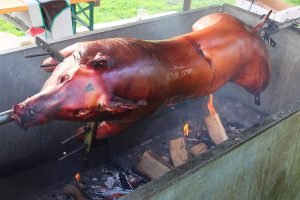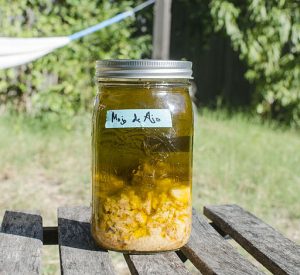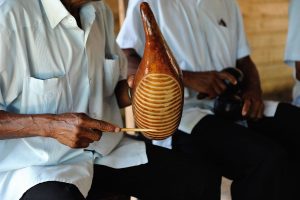57 Guajira
“Música guajira” es la base rítimica para la salsa. Guajiros son los cubanos hispanos que viven en el interior o la parte más lejana (=far away) de la costa o de la plara. El sonido es muy similar a la salsa, pero con instrumentos tradicionales y they don’t belong to the salsa industry that developed later in New York.
There may be controversy on whether this is early salsa, son cubano, son cubano, bolero or other kinds of subgenres that a folklorist may find more specific to the songs listed here. Calling it “guajira” is a good generic name for the countryside Cuban music outside the salsa industry.
Son de la loma
This was one of the first canciones ever recorded from guajira cubana. The authorship goes to Trío Matamoros, a group of three singers constituted in 1925. In the voice of a child, the singer asks his mom where the singers are from. Es una referencia a lo inocencia y candor de la persona campesina cubana.
- Yo quiero saber de dónde son los cantantes=I want to know where the singers are from, SABER=to know information, in this case, where they are from.
- Los quiero conocer= I want to know them (in person) OR I want to meet them, CONOCER=to know them in person
- La quiero aprender=I want to know it (=la trova, feminine word)
- Serán=may they be, verb “to be” conjugated in the real future tense= a guess.
Mamá yo quiero saber de donde son los cantantes
Mom I want to know where the singers are from
Que lo (=los) encuentro muy galantes
That I find them very elegant
Y los quiero conocer
And I want to know/meet them
Con su trova fascinante que me la quiero aprender
With their fascinating verse that I want to learn it
¿De donde serán? ay mamá
Where may they be from? Ay mom
¿Serán de la Habana?
May they be from La Habana?
¿Serán de Santiago? Tierra soberana
May they be from Santiago? Sovereign land
Son de la loma y cantan en el llano, ya verás, tu verás
They’re from the hill and sing in the plain, you’ll see, you’ll see
Mamá ellos son de la loma
Mom they’re from the hill
Mamá ellos cantan en el llano
Mom they sing in the plain
Songwriters: Miguel Matamoros. For non-commercial use only.
Guantanamera
Otra canción llamada “Guantanamera” es una guajira basada en un poema del poeta cubano José Martí (1853-1895), que habla de su amor por su lugar: “Guantánamo”. La palabra guantanamera is an adjective in feminine that agrees with the feminine canción. Joseíto Fernández first popularized the song on radio as early as 1929 (although it is unclear when the first release as a record occurred).
La canción canta a la inocencia del hombre campesino cubano (sí, dice “hombre”, no mujer). Por eso empieza: yo soy un hombre sincero de donde crece la palma=I am an honest man where from the palm grows. Then: y antes de morir yo quiero tirar mis versos del alma=and before to die I want to throw the lines from the soul.
It has been object to endless covers and versions.
Company Segundo Guajira guantanamera.
Guantanamera
Guajira Guantanamera
Guantanamrera
Guajira Guantanamera
Yo soy un hombre sincero
I’m a sincere man
De donde crece la palma
From where the palm grows
Yo soy un hombre sincero
I’m a sincere man
De donde crecen las palmas
From where the palm grow
Y antes de morir yo quiero
And before dying I want)
Echar mis versos del alma
To throw the verse from the soul
No me pongan (subjunctive) en lo oscuro
Don’t put me in the dark
A morir como un traídor
To die as a traitor
No me pongan en lo oscuro
Don’t put me in the dark
A morir como un traidor
To die as a traitor
Yo soy bueno y como bueno
I’m good and as good
Moriré de cara al sol
I’ll die of face to sun
Songwriters: Christian Bruhn, Jose Fernandez Diaz. For non-commercial use only.
Guateque campesino
In Guateque campesino (1950’s), la palabra guateque es otra forma para “fiesta”. En español hay muchas palabras para fiesta: parranda, rumba, juerga, pachanga, among others. En la canción, the guateque ocurre porque es el cumpleaños (=birthday) de Mr. Ramón. En la canción dicen “es santo de don Ramón”. There’s an old tradition to name babies after the saint whose devotion happens at the day, and each day is devoted to a different saint. Por eso (=for that), el cumpleaños es el santo.
The version by Ibrahim Ferrer says “bailadores” in masculine, which refers to folk dancers.
IBRAHIM FERRER /Guateque campesino
The version by Guillermo Portabales says the word “bailadoras” in femenine, like it’s the group of female-only folk dancers who arrive to the guateque:
Guateque Campesino (Celia Romero) – Guillermo Portabales by AboubacarSiddikh
La canción exagera el poder de la música y el guateque. Exagera que viene mucho gentío y que el poder de la fiesta va a romper los muros de los ranchos. The energy will be so intense that el bohío (=shack) is going to fall down and people is not going to fit in the space.

Undivided back
[1903] – Public domain
- Food: yuca (=yucca), lechón (=pork), plátano verde (=green plantain), plántano pintón (=yellowish plantain), mojo (=garlic and orange juice dressing)
- People: compadre (=shared Godfather), comadre (=shared Godmother), comay (=shortening of “comadre”), gentío (=crowd), bailadores (=folk dancers), bailadoras (=female folk dancers), guajiros (=Cuban peasants)
- Outfit: guayabera (=Cuban shirt of four pockets), polaina (=boot cover), machete (=knife for farming)
- Building items: bohío (=Cuban shack), talanquera (=barricade), taburetes (=stools)
- Instrumentos: güiro /gwyro/ (=rough Surface with stick), triple (=Cuban string instrument), bongo (=Cuban drum)
- Slang: caminuá tah cáuh=caminos atascados=twisted trails, sancochá=sancocháda=turned into stew, sitiera=farm
GUAYABERA: Masculine short-sleeve shirt with four pockets to store GUAYABAS (guava). If you watched the TV series “The baker and the beauty”, this is the type of shirt the dad of Daniel usually wears.

PLÁTANO VERDE Y PINTÓN: Plantain may be green or ripe, but sometimes it’s something in between: pintón. It looks yellow, but it’s not ripe yet.

LECHÓN: El lechón en la púa refers to a way to roast the pork where you insert it into a spike and low cook it on the fire.

MOJO DE AJO: Seasoning made of chopped garlic and orange juice. Good garment for meats, yucca, ensalada or whatever you want.

GÜIRO: Empty round device with rough surface to be rubbed against with a stick. See also these musicians wearing a two-pocket guayabera.

How to Play the Guiro
TRIPLE: a type of guitar with three sets of double strings.
How To Play Tumbao in A minor on Tres Cubano as played by Pancho Amat.
El compadrazgo
La canción menciona COMPADRE y COMADRE, which in Cuban Spanish are also said COMPAY and COMAY.
It comes from the Catholic tradition of baptism. The baptism is a ritual in a priest adds holly water to a baby to make their body sacred and commit the individual into the Catholic faith. Baptism is supposed to avoid the original punishment inflicted to Adam and Eve at the beginning of the times.
El padre y la madre del hijo seleccionan un padrino (godfather) y una madrina (godmother) for their baby. The baby becomes the ahijado (male) OR ahijada (female) of their godparents. This selection allows for the creation of new social ties or family outside family. It was costume to choose a godmother and a godfather among the wealthy to good presents for own’s children.
The relationship between los padres y los padrinos se llama compadrazgo (co-godparenthood). Both the parents and godparents became compadres and comadres with each other. Later on, the term “compadre” and “comadre” became nicknames for friends, like saying “buddy”, even when there was not this baptism relationship.
Nowadays it’s not that common to pick madrina and padrino outside the family. Sometimes el abuelo (grandpa) o la abuela (grandma) are selected to be padrino o madrina. Sometimes it’s un tío (uncle) o una tía (aunt) that become padrino or madrina for their niece (sobrina) or nephey (sobrino).
The next lyrics show the slight differences between the version by Ibrahim Ferrer and by Guillermo Portabeles by underlining first the version by Ferrer and second the version by Portabeles.
Hay guateque en el bohío
There’s party (slang) in the shack
Del compadre Don Ramón OR Juan Ramón(X2)
From the co-godfather Mr. Ramón / Juan Ramón
Ya está en la púa OR puya el lechón
Now in the spike the pork is (located)
Ya está llegando el gentío
Now the crowd is coming.
Hoy viene abajo el bohío
Today comes down the shack
Es santo de Don Ramón
It’s saint (birthday) of Mr. Ramón.
Coro
Y llegando bailadores OR bailadoras, comay
And coming dancers (male) OR dancers (female), co-godmom
Por los camino(s) atasca(d)os (X2)
Through the stuck trails/paths.
El bongó, el triple y el güiro
Nuan (=no han) cesado de tocar (X2)
They-haven’t stopped of to play
Porque así son los guajiros
Because so the guajiros (Cuban countryside people) are
No tienen cuando acabar
They don’t have when to finish
Es costumbre campesina OR de los guajiros
It’s countryside tradition OR of the guajiros
Desde el tiempo colonial (Coro)
Since the colonial time
Ya la comadre Caruca
Now the Caruca co-godmother
De OR con tres piedras hizo el fogón (X2)
(Out) of OR with three stones (she) made the bonfire
Ya está sancochá (=sancocháda) la yuca
Now the yucca is boiled (slang)
Ya está el mojo pal (=para el) lechón
Now the mojo (traditional seasoning) is (ready) for the pork
Y ya Juan Ramón fue en busca
And now Juan Ramón went in the quest
De plátano verde y pintón
Of the green plaintain and redish (coro)
HERE ENDS THE VERSION BY GUILLERMO PORTABELES
Hoy luce su guayabera
Today (he) boasts his guayabera
Su polaina y su machete (X2)
His leg-covering and his machete (traditional knife)
Los guajiros y la sitiera
The guajiros and the farm (Cuban slang)
Que engalanan su guateque
That adorn its party (slang)
Hoy se rompen los taburetes
Today the stools get broken
Y se cae la talanquera
And falls the barricade.
Songwriters: Celia Romero Gomez. For non-commercial use only. Adapted from Musixmatch, powered Microsoft Bing
The Cuban revolution
Spain dominated Cuba until the United States-Spain war in 1898, when Cuba gained its independence. The United States didn’t add Cuba to its domains, but it did add Puerto Rico. Despite this, the United States intervened in Cuban economy a lot. There was a DICTATORSHIP that lasted almost 20 years until 1959 BEFORE THE COMMUNIST.
In 1959, fighters against the dictatorship took-over power, and settled a communist government. Artists of traditional Cuban music fled the island and settled in the United States. Salsa comes from the artists who arrived in the United States and mixed Guajira music with Latin Jazz. Celia Cruz was one of the first artists who became famous in the United States.
In Cuba, artists continued doing traditional Cuban music. Carlos Puebla was an artist who used Guajira to sing for the communist government around the 1960’s. Their traditional music remained being guajira with its rich amount of subgenre.
De Cuba Traigo un Cantar (Remastered) by Carlos Puebla – Topic.
- YO-GO verbs: traigo (=I bring), from the infinitve traer. He repeats “Traigo un cantar de mi Cuba” and then reverses it “De Cuba traigo un cantar”.
- Vocab: palma (=palm), sol (=sun), vida nueva (=new life), ensueño (=daydreaming), trabajo (=job, work), campana (=bell), mejor (=better), mayor (=greater, older), esperanza (=hope), alegría (=joy), ternura (=sweetness), calor (=heat), candor (=innocence)
Coro:
Traigo un cantar de mi Cuba
I-bring a singing from my Cuba
De Cuba traigo un cantar
From my Cuba I-bring a singing
De Cuba traigo un cantar
From Cuba I-bring a singing
Hecho de palma y de sol
Made of palm and of sun
Cantar de la vida nueva
Singing of the new life
y del trabajo creador
And from the work creator
De Cuba traigo un cantar
From Cuba I-bring a singing
Para el ensueño mejor
For the best daydream
Cantar para la esperanza
Singing for the hope
Para la luz y el amor
For the light and the love
De Cuba traigo un cantar
From Cuba I-bring a singing
En cuya nota mejor
In which best (musical) note
Vibra la campana alegre
Vibrates the bell joyful
De la alegría mayor
From the major joy
De Cuba traigo un cantar
From Cuba I-bring a singing
Donde late la pasión
Where the passion beats
De la más honda ternura
From the deepest sweetness
Y del más tierno calor
And form the sweetest heat
De Cuba traigo un cantar
From my Cuba I-bring a singing
Para tu dulce candor
For your sweet innocence
Para decirte “hasta luego”
To tell you “see you later”
Con esta dulce cancion
With this sweet song
Songwriters: Puebla Carlos. For non-commercial use only. Adapted from Musixmatch, powered Microsoft Bing.
